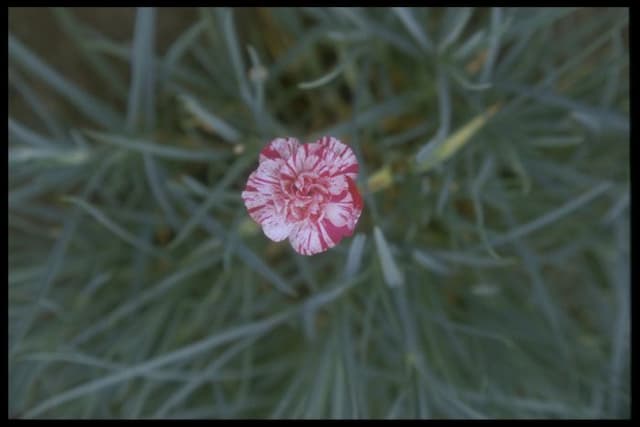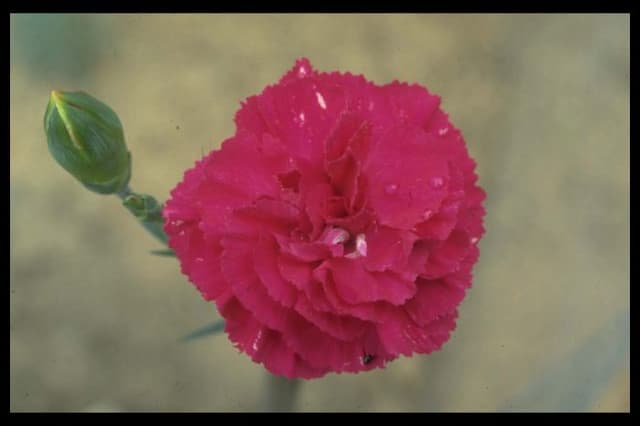Zawadzki's campion Silene zawadskii

ABOUT
Silene zawadskii, commonly known as Zawadski's campion, is a perennial plant that is notable for its unique and attractive foliage and flowers. The plant typically has a rosette of basal leaves from which stems emerge. These leaves are usually oval-shaped to lance-shaped, with a smooth to slightly hairy surface, giving a soft texture to the touch. The color of the leaves ranges from a deep green to grayish-green, providing a lush appearance even when the plant is not in bloom. The stems of Zawadski's campion are slender and straight, rising above the foliage and sometimes branching to form a loose cluster. The flowering part of the plant is particularly eye-catching, with the presence of numerous flowers which add a delicate charm. Each flower has five petals that are usually pink to purple, with a lighter center and darker veins running through them. The petals have a distinct notch at the tip, creating a deeply divided look that can resemble a miniature crown. At the center of each flower, there's a group of contrasting stamens that often stand out against the petals. The flowers are arranged individually or in small clusters at the top of the stems, and they bloom from late spring to early summer, attracting pollinators to the garden. The overall appearance of Zawadski's campion is one of subtle beauty, with its combination of soft foliage and vibrant, eye-catching flowers that add a splash of color to naturalistic planting schemes.
About this plant
 Names
NamesFamily
Caryophyllaceae
Synonyms
Zawadski's Campion, Zawadski's Catchfly, Zawadski's Silene
Common names
Atocion rupestre var. deltoideum, Lychnis viscaria var. atropurpurea, Melandrium silenoides, Silene chlorantha, Silene zawadskii var. prostrata, Silene zawadskii var. zawadskii.
 Toxicity
ToxicityTo humans
Silene zawadskii, commonly known as Zawadski's Campion, is not widely recognized for its toxicity to humans. There is limited information available on the specific toxic properties or potential symptoms of poisoning. However, as with many plants, it is generally advisable to avoid ingesting any part of plants that are not known to be edible, as they could potentially contain harmful compounds that may cause adverse effects. If accidental ingestion occurs, it is important to seek medical advice. Always exercise caution and consult with a healthcare provider or a poison control center if any part of a plant with unknown edibility is consumed.
To pets
In the case of pets, there is no well-documented or specific information available about the toxicity of Zawadski's Campion (Silene zawadskii) to animals such as dogs and cats. Therefore, it is not possible to provide a detailed description of symptoms of poisoning from this plant in pets. However, as a general rule, it is prudent to prevent pets from eating plants unless they are known to be safe, since many plants can have toxic effects on animals. If a pet ingests any part of this plant, or any other plant with unknown effects, it is recommended to contact a veterinarian or an animal poison control service promptly for advice on how to proceed.
 Characteristics
CharacteristicsLife cycle
Perennials
Foliage type
Deciduous
Color of leaves
Green
Flower color
Pink
Height
1-2 feet (30-60 cm)
Spread
1-1.5 feet (30-45 cm)
Plant type
Herb
Hardiness zones
4
Native area
Asia
Benefits
 General Benefits
General Benefits- Ecosystem Support: Provides food and habitat for a variety of insects and animals.
- Biodiversity: Contributes to the genetic diversity within its native ecosystem.
- Soil Erosion Control: Helps stabilize soil with its root system, preventing erosion.
- Aesthetic Value: Adds beauty to natural landscapes with its flowers and foliage.
- Pollinator Attraction: Flowers serve as a nectar source for bees and other pollinators.
- Low Maintenance: Typically requires little care once established in a suitable habitat.
- Adaptability: Can survive in various soil types, often thriving in rocky or poor soils.
 Medical Properties
Medical PropertiesThis plant is not used for medical purposes.
 Air-purifying Qualities
Air-purifying QualitiesThis plant is not specifically known for air purifying qualities.
 Other Uses
Other Uses- Silene zawadskii, commonly known as Zawadski's campion, can be used as a natural dye source, providing a range of colors extracted from its petals and roots depending on the mordant used.
- The plant's fibrous material may be used for creating paper, especially in artisanal crafts where its unique texture and plant remnants can add decorative quality to the final product.
- Gardeners might use Zawadski's campion as ground cover, to suppress weeds due to its mat-forming growth habit, contributing to low-maintenance landscaping.
- Zawadski's campion can be a useful addition to rock gardens, providing a hardy option that can survive in the shallow soil and enhance the aesthetic with its flowers.
- Dried specimens of Silene zawadskii may be used in potpourris, combining their subtle fragrance with other dried flowers and herbs.
- Floral artists might use the delicate blossoms of Zawadski's campion in live floral arrangements, adding a unique touch to bouquets and centerpieces.
- In educational settings, Silene zawadskii could serve as an example in botany studies to illustrate plant survival mechanisms in alpine environments.
- Photographers and nature enthusiasts might appreciate Zawadski's campion for its visual appeal, capturing the beauty of its blooms in various forms of media.
- Conservationists may utilize Silene zawadskii in habitat restoration projects to support the local ecosystem and provide food for pollinators.
- As part of a sensory garden, the plant's texture and form can offer a tactile experience, contributing to gardens designed for therapeutic and educational purposes.
Interesting Facts
 Feng Shui
Feng ShuiThe Silene zawadskii is not used in Feng Shui practice.
 Zodiac Sign Compitability
Zodiac Sign CompitabilityThe Silene zawadskii is not used in astrology practice.
 Plant Symbolism
Plant Symbolism- Rarity: As Silene zawadskii, commonly known as Zawadzki's Campion, is a species not as well-known or widely recognized, it may symbolize something rare or unique.
- Survival: Given that campions can thrive in various conditions, it can symbolize adaptability and the ability to survive through a range of challenges.
- Beauty: Campions, in general, have attractive flowers, which can symbolize beauty and the aesthetic pleasure nature provides.
- Purity: The flowers of Zawadzki's Campion are often light-colored, which may symbolize purity and innocence.
 Water
WaterZawadski's Catchfly requires moderate watering, particularly during its growing season in spring and summer. Water the plant when the top inch of soil feels dry, which might be roughly once a week, but this can depend on climate conditions such as temperature and humidity. Use room temperature water and apply it directly to the soil to avoid soaking the foliage, which can lead to fungal diseases. A good rule of thumb is to water with one to two gallons every two weeks, adjusting based on weather conditions and the plant's response. Overwatering can be detrimental, so ensure the soil is well-drained and never soggy.
 Light
LightZawadski's Catchfly thrives best in full sun to partial shade conditions. The ideal spot for this plant is an area where it can receive at least six hours of sunlight per day. However, in very hot climates, some afternoon shade can be beneficial to prevent scorching. Avoid deep shade, as it can lead to leggy growth and fewer flowers.
 Temperature
TemperatureZawadski's Catchfly prefers temperate climates and can survive a temperature range from about 35 degrees Fahrenheit to 85 degrees Fahrenheit. The ideal temperature for this plant is between 65 degrees Fahrenheit and 75 degrees Fahrenheit during the day, with cooler night temperatures. Sudden temperature fluctuations and frost can damage or kill the plant, so ensure it is not exposed to temperatures below freezing.
 Pruning
PruningPruning Zawadski's Catchfly is important to maintain its shape, encourage bushier growth, and stimulate more flowering. Prune the plant in early spring to remove dead or damaged stems and shape the plant. Deadheading, or removing spent flowers, can be done throughout the flowering season to promote continuous blooming. The best time to prune for shaping is just before new growth begins.
 Cleaning
CleaningAs needed
 Soil
SoilZawadski's Catchfly prefers a well-draining soil mix with a pH range of 6.0 to 7.5. A blend of loam, sand, and compost is ideal to ensure adequate drainage and nutrient availability. Regular garden soil amended with perlite or pumice can also support healthy growth.
 Repotting
RepottingZawadski's Catchfly does not require frequent repotting; it can be repotted every 2 to 3 years. It is best to repot in the spring when the plant resumes active growth, ensuring minimal disturbance to the roots.
 Humidity & Misting
Humidity & MistingZawadski's Catchfly thrives in moderate humidity levels but is adaptable to a wide range of conditions. There is no specific humidity requirement, but it typically does well in typical outdoor humidity levels.
 Suitable locations
Suitable locationsIndoor
Provide bright indirect light and moderate watering.
Outdoor
Plant in full sun to partial shade in well-draining soil.
Hardiness zone
4-8 USDA
 Life cycle
Life cycleSilene zawadskii, commonly known as Zawadski's campion, begins its life cycle as a seed, which, upon favorable conditions of temperature and moisture, germinates and grows into a seedling. The seedling stage is marked by the development of roots and a shoot that emerges above the soil surface. As it enters the vegetative stage, the plant develops a rosette of leaves and undergoes significant root and foliage growth. The next stage is the flowering phase, during which Zawadski's campion produces distinct flowers that are capable of cross-pollination, often facilitated by insects. Following pollination and fertilization, seeds develop within the fruit, which is usually a capsule that opens to release the seeds upon maturity. The plant completes its cycle when these seeds disperse, potentially giving rise to the next generation.
 Propogation
PropogationPropogation time
Early spring
The most popular method of propagation for Silene zawadskii, commonly known as Zawadski's Campion, is by seed. To propagate Zawadski's Campion, sow the seeds directly into the soil in the spring after the threat of frost has passed. The ideal soil temperature for seed germination is around 70°F (approximately 21°C). The seeds should be placed on the surface of the soil and lightly pressed in, as they require light to germinate. Seedlings will emerge in two to three weeks. Care should be taken to ensure the soil remains moist but not waterlogged during the germination and early growth periods. Thin seedlings to allow sufficient space for the plants to reach full size.






![Pink [Coconut Sundae]](/_next/image?url=https%3A%2F%2Fplants-admin.emdemapps.com%2Fimages%2Fplants%2F%2Fimages%2F604b5d09d4fd1.png&w=640&q=75)


